-
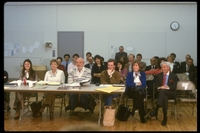 Photograph: collaborators at the first rehearsal of "A Doll's Life."
Photograph: collaborators at the first rehearsal of "A Doll's Life." This photograph shows one of the most important stage managers in professional theater, Ruth Mitchell, in her natural habitat. Ruth Mitchell was one of the first women to really make stage managing a career. She worked alongside Harold “Hal” Prince for many years as his main stage manager. Hal Prince was one of the most prominent theater makers of the 20th century. Stage managers are often referred to as the “right hand” of the director. And here we see Ruth Mitchell on the literal right side of Hal Prince, the director.
-
 Print: Stage Manager and Prompter
Print: Stage Manager and Prompter This print is from the Victoria and Albert Museum in London. The print is from the Harry Beard collection. It shows a stage manager reading from a prompt script and waiting for his cue to pull the curtain. For a position in the theater that didn’t really become its own career until later in the 20th century, this rendering is a great representation of what stage managing is. It’s trying to look at multiple documents, stay in the moment, and also remember where all the technical cues go at any given moment.
-
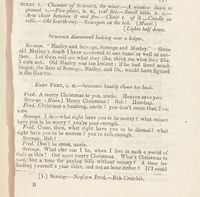 A Christmas carol, or, Past, present, and future
A Christmas carol, or, Past, present, and future This script is a document that was taken from Charles Dickens’ famous story A Christmas Carol. The script was adapted from the book. This production of A Christmas Carol was put on at the Theatre Royal, Adelphi. In this script is a list of all the technical cues that are required to put on this particular production of A Christmas Carol. It includes the list of all entrances and exits as well as scenery plots, a list of the props needed, call times, any incidents that may have occurred, and a copy of the original Playbill.
-
 Prompt script, Garrick Gaieties
Prompt script, Garrick Gaieties This prompt script is from the show Garrick Gaieties among others. There are many one-act shows in this one grouping of scripts. This script also includes a list of all the technical cues that were required to put on this production of Garrick Gaieties. This production of Garrick Gaieties was put on by the Theatre Guild, an independent theater company that existed in NYC in the early 20th century. It was founded in 1919.
-
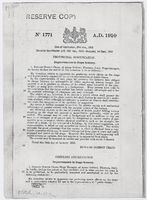 Patent application for folding screens
Patent application for folding screens
This document is an application for stage screens. It’s part of a collection regarding the life and career of Edward Gordan Craig. In this document, one reads that Craig is applying for stage screens in order to help with the special effects that he’s trying to accomplish on stage. As the stage manager, this is not something that we necessarily see nowadays with modern stage management, but it’s important nonetheless. Craig is advocating for his production as the stage manager and as the designer. Craig’s career seemed to run the gambit of acting, directing, stage managing, and designing.
-
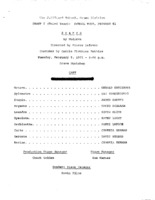 Scapin Theatrical Program
Scapin Theatrical Program This is a copy of the program for a production of Scapin at the Juilliard School in New York City. The program is for a Drama Division show that starred the now very prominent actor Patti Lupone and had Kevin Kline, another prominent actor, as the student stage manager. This program shows that even some actors had to start their careers as stage managers, so a lot of them can appreciate all the work that goes into it even when they’ve moved on.
-
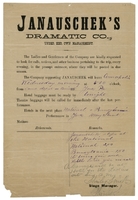 Notice of travel information for actors of Janauschek’s Dramatic Co., Annapolis
Notice of travel information for actors of Janauschek’s Dramatic Co., Annapolis This is a form from the collection at the Folger Shakespeare Library. It’s from the 19th or 20th century and it has information about travel for the company of Mary Stuart. The note is signed by the stage manager Shirley Smith. This is an interesting document because it’s not something that necessarily gets saved. Nowadays this document would be sent in an email. It would probably also be posted on the callboard for the company to see, but it probably wouldn’t get archived in any real way. It’s fascinating to see how an analog item that doesn’t seem to be super important in the moment has a lot of intrinsic value much later in time.
-
 Stage manager's reports for A Trip to Japan
Stage manager's reports for A Trip to Japan In this particular report, the stage manager is notating the arrival times of actors and if they need extra pay for their time. In modern times, the stage manager keeps track of how many hours their team and the actors work. Because the actors and the stage managers are all part of the same union, the hours that they’re working vary from contract to contract. So it’s important that someone is keeping track of all of those elements. In this case, the stage manager is noting what time actors arrive at rehearsal. Lateness will potentially affect how they’re paid.
-
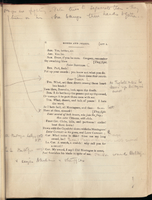 Romeo and Juliet Prompt Book
Romeo and Juliet Prompt Book This prompt book was created by Audrey Cameron, the assistant stage manager or ASM on this production of Romeo and Juliet. This particular production of Romeo and Juliet took place at the Everyman Theatre in Hampstead, England in October of 1921. It shows the different blocking (all movements of the actors) and the cues for them to enter and exit. Stage managers nowadays have different tasks assigned to them depending on the team they’re on, but usually the PSM or Production Stage Manager will be the one to take down the blocking in a production.
-
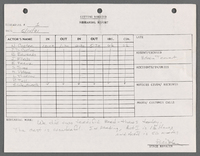 Rehearsal Report: Getting Married
Rehearsal Report: Getting Married The stage manager has to create many different forms to use throughout the theatrical process. One of the most important forms is a rehearsal report. This report includes all details related to what goes on in a day’s rehearsal. It says who’s in and who’s out, what was actually rehearsed, and any notes for the production. The notes are for anyone who’s not in the rehearsal room. This includes the designers, production manager, company manager among others. This form has evolved a lot over time, but here is a great example of a very detailed report from 1991 for a production of Getting Married.
 Photograph: collaborators at the first rehearsal of "A Doll's Life." This photograph shows one of the most important stage managers in professional theater, Ruth Mitchell, in her natural habitat. Ruth Mitchell was one of the first women to really make stage managing a career. She worked alongside Harold “Hal” Prince for many years as his main stage manager. Hal Prince was one of the most prominent theater makers of the 20th century. Stage managers are often referred to as the “right hand” of the director. And here we see Ruth Mitchell on the literal right side of Hal Prince, the director.
Photograph: collaborators at the first rehearsal of "A Doll's Life." This photograph shows one of the most important stage managers in professional theater, Ruth Mitchell, in her natural habitat. Ruth Mitchell was one of the first women to really make stage managing a career. She worked alongside Harold “Hal” Prince for many years as his main stage manager. Hal Prince was one of the most prominent theater makers of the 20th century. Stage managers are often referred to as the “right hand” of the director. And here we see Ruth Mitchell on the literal right side of Hal Prince, the director. Print: Stage Manager and Prompter This print is from the Victoria and Albert Museum in London. The print is from the Harry Beard collection. It shows a stage manager reading from a prompt script and waiting for his cue to pull the curtain. For a position in the theater that didn’t really become its own career until later in the 20th century, this rendering is a great representation of what stage managing is. It’s trying to look at multiple documents, stay in the moment, and also remember where all the technical cues go at any given moment.
Print: Stage Manager and Prompter This print is from the Victoria and Albert Museum in London. The print is from the Harry Beard collection. It shows a stage manager reading from a prompt script and waiting for his cue to pull the curtain. For a position in the theater that didn’t really become its own career until later in the 20th century, this rendering is a great representation of what stage managing is. It’s trying to look at multiple documents, stay in the moment, and also remember where all the technical cues go at any given moment. A Christmas carol, or, Past, present, and future This script is a document that was taken from Charles Dickens’ famous story A Christmas Carol. The script was adapted from the book. This production of A Christmas Carol was put on at the Theatre Royal, Adelphi. In this script is a list of all the technical cues that are required to put on this particular production of A Christmas Carol. It includes the list of all entrances and exits as well as scenery plots, a list of the props needed, call times, any incidents that may have occurred, and a copy of the original Playbill.
A Christmas carol, or, Past, present, and future This script is a document that was taken from Charles Dickens’ famous story A Christmas Carol. The script was adapted from the book. This production of A Christmas Carol was put on at the Theatre Royal, Adelphi. In this script is a list of all the technical cues that are required to put on this particular production of A Christmas Carol. It includes the list of all entrances and exits as well as scenery plots, a list of the props needed, call times, any incidents that may have occurred, and a copy of the original Playbill. Prompt script, Garrick Gaieties This prompt script is from the show Garrick Gaieties among others. There are many one-act shows in this one grouping of scripts. This script also includes a list of all the technical cues that were required to put on this production of Garrick Gaieties. This production of Garrick Gaieties was put on by the Theatre Guild, an independent theater company that existed in NYC in the early 20th century. It was founded in 1919.
Prompt script, Garrick Gaieties This prompt script is from the show Garrick Gaieties among others. There are many one-act shows in this one grouping of scripts. This script also includes a list of all the technical cues that were required to put on this production of Garrick Gaieties. This production of Garrick Gaieties was put on by the Theatre Guild, an independent theater company that existed in NYC in the early 20th century. It was founded in 1919. Patent application for folding screens This document is an application for stage screens. It’s part of a collection regarding the life and career of Edward Gordan Craig. In this document, one reads that Craig is applying for stage screens in order to help with the special effects that he’s trying to accomplish on stage. As the stage manager, this is not something that we necessarily see nowadays with modern stage management, but it’s important nonetheless. Craig is advocating for his production as the stage manager and as the designer. Craig’s career seemed to run the gambit of acting, directing, stage managing, and designing.
Patent application for folding screens This document is an application for stage screens. It’s part of a collection regarding the life and career of Edward Gordan Craig. In this document, one reads that Craig is applying for stage screens in order to help with the special effects that he’s trying to accomplish on stage. As the stage manager, this is not something that we necessarily see nowadays with modern stage management, but it’s important nonetheless. Craig is advocating for his production as the stage manager and as the designer. Craig’s career seemed to run the gambit of acting, directing, stage managing, and designing. Scapin Theatrical Program This is a copy of the program for a production of Scapin at the Juilliard School in New York City. The program is for a Drama Division show that starred the now very prominent actor Patti Lupone and had Kevin Kline, another prominent actor, as the student stage manager. This program shows that even some actors had to start their careers as stage managers, so a lot of them can appreciate all the work that goes into it even when they’ve moved on.
Scapin Theatrical Program This is a copy of the program for a production of Scapin at the Juilliard School in New York City. The program is for a Drama Division show that starred the now very prominent actor Patti Lupone and had Kevin Kline, another prominent actor, as the student stage manager. This program shows that even some actors had to start their careers as stage managers, so a lot of them can appreciate all the work that goes into it even when they’ve moved on. Notice of travel information for actors of Janauschek’s Dramatic Co., Annapolis This is a form from the collection at the Folger Shakespeare Library. It’s from the 19th or 20th century and it has information about travel for the company of Mary Stuart. The note is signed by the stage manager Shirley Smith. This is an interesting document because it’s not something that necessarily gets saved. Nowadays this document would be sent in an email. It would probably also be posted on the callboard for the company to see, but it probably wouldn’t get archived in any real way. It’s fascinating to see how an analog item that doesn’t seem to be super important in the moment has a lot of intrinsic value much later in time.
Notice of travel information for actors of Janauschek’s Dramatic Co., Annapolis This is a form from the collection at the Folger Shakespeare Library. It’s from the 19th or 20th century and it has information about travel for the company of Mary Stuart. The note is signed by the stage manager Shirley Smith. This is an interesting document because it’s not something that necessarily gets saved. Nowadays this document would be sent in an email. It would probably also be posted on the callboard for the company to see, but it probably wouldn’t get archived in any real way. It’s fascinating to see how an analog item that doesn’t seem to be super important in the moment has a lot of intrinsic value much later in time. Stage manager's reports for A Trip to Japan In this particular report, the stage manager is notating the arrival times of actors and if they need extra pay for their time. In modern times, the stage manager keeps track of how many hours their team and the actors work. Because the actors and the stage managers are all part of the same union, the hours that they’re working vary from contract to contract. So it’s important that someone is keeping track of all of those elements. In this case, the stage manager is noting what time actors arrive at rehearsal. Lateness will potentially affect how they’re paid.
Stage manager's reports for A Trip to Japan In this particular report, the stage manager is notating the arrival times of actors and if they need extra pay for their time. In modern times, the stage manager keeps track of how many hours their team and the actors work. Because the actors and the stage managers are all part of the same union, the hours that they’re working vary from contract to contract. So it’s important that someone is keeping track of all of those elements. In this case, the stage manager is noting what time actors arrive at rehearsal. Lateness will potentially affect how they’re paid. Romeo and Juliet Prompt Book This prompt book was created by Audrey Cameron, the assistant stage manager or ASM on this production of Romeo and Juliet. This particular production of Romeo and Juliet took place at the Everyman Theatre in Hampstead, England in October of 1921. It shows the different blocking (all movements of the actors) and the cues for them to enter and exit. Stage managers nowadays have different tasks assigned to them depending on the team they’re on, but usually the PSM or Production Stage Manager will be the one to take down the blocking in a production.
Romeo and Juliet Prompt Book This prompt book was created by Audrey Cameron, the assistant stage manager or ASM on this production of Romeo and Juliet. This particular production of Romeo and Juliet took place at the Everyman Theatre in Hampstead, England in October of 1921. It shows the different blocking (all movements of the actors) and the cues for them to enter and exit. Stage managers nowadays have different tasks assigned to them depending on the team they’re on, but usually the PSM or Production Stage Manager will be the one to take down the blocking in a production. Rehearsal Report: Getting Married The stage manager has to create many different forms to use throughout the theatrical process. One of the most important forms is a rehearsal report. This report includes all details related to what goes on in a day’s rehearsal. It says who’s in and who’s out, what was actually rehearsed, and any notes for the production. The notes are for anyone who’s not in the rehearsal room. This includes the designers, production manager, company manager among others. This form has evolved a lot over time, but here is a great example of a very detailed report from 1991 for a production of Getting Married.
Rehearsal Report: Getting Married The stage manager has to create many different forms to use throughout the theatrical process. One of the most important forms is a rehearsal report. This report includes all details related to what goes on in a day’s rehearsal. It says who’s in and who’s out, what was actually rehearsed, and any notes for the production. The notes are for anyone who’s not in the rehearsal room. This includes the designers, production manager, company manager among others. This form has evolved a lot over time, but here is a great example of a very detailed report from 1991 for a production of Getting Married.